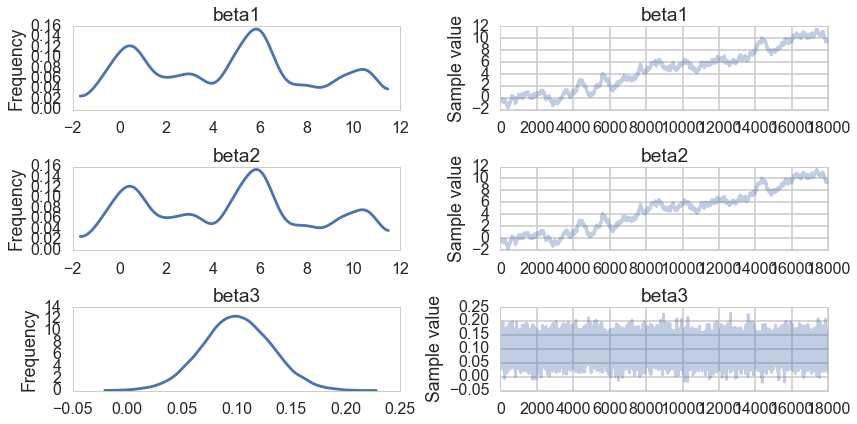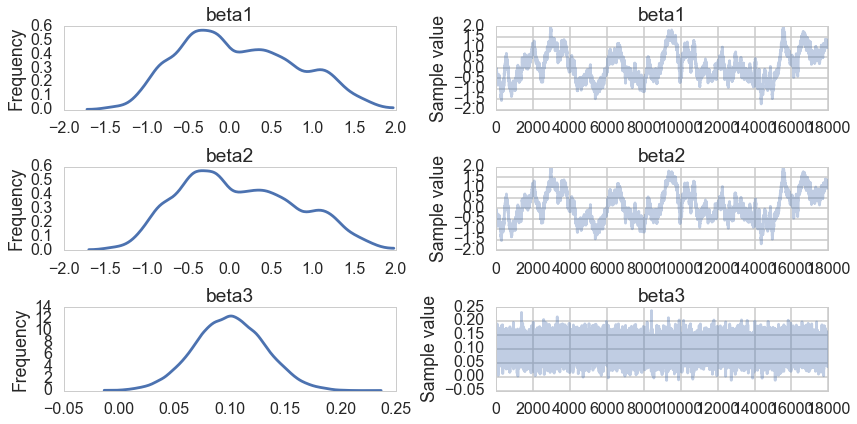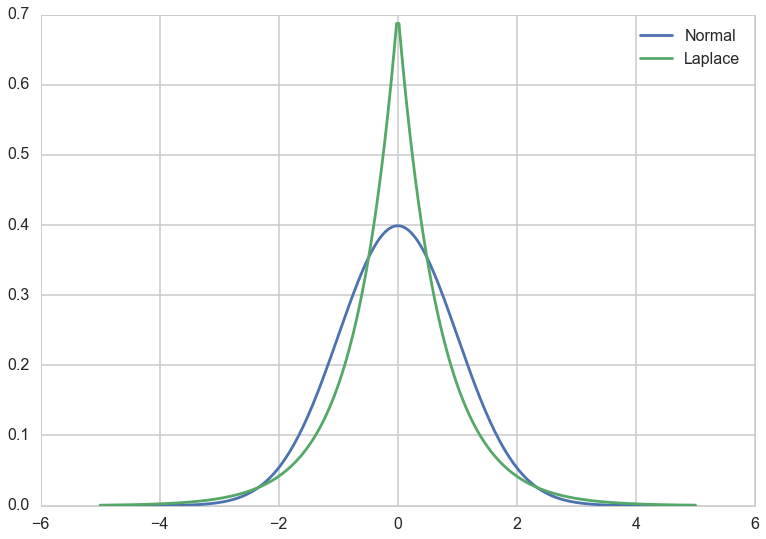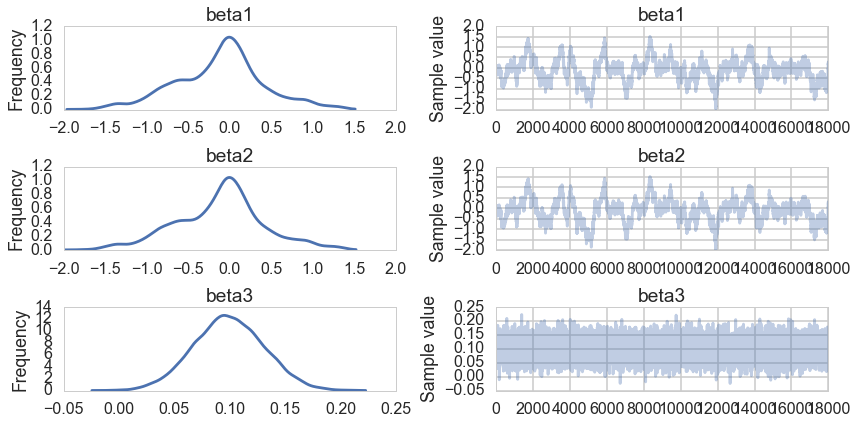Keywords: ridge | lasso | identifiability | map | mcmc | bayesian | Download Notebook
Contents
Contents
%matplotlib inline
import numpy as np
import scipy as sp
import matplotlib as mpl
import matplotlib.cm as cm
import matplotlib.pyplot as plt
import pandas as pd
pd.set_option('display.width', 500)
pd.set_option('display.max_columns', 100)
pd.set_option('display.notebook_repr_html', True)
import seaborn as sns
sns.set_style("whitegrid")
sns.set_context("poster")
This note provides an example of ridge regression and lasso regression in the face of a model with unidentifiable variables. We see that MCMC has problems, but both MAP and MCMC estimation have some patterns in the ridge and lasso case. In lasso, the choice of a Laplace prior kills the non-identifiable parts.
This note is based on a blog post by Austin Rochford, which itself is based on a blog post by our textbook author Cam Davidson Pilon. We construct a model
where $x_1 \sim N(0,1)$, $x_2 = -x_1 + N(0, 10^{-3})$ and $x_3 \sim N(0,1)$
Thus our real model is
from scipy.stats import norm
n = 1000
x1 = norm.rvs(0, 1, size=n)
x2 = -x1 + norm.rvs(0, 10**-3, size=n)
x3 = norm.rvs(0, 1, size=n)
X = np.column_stack([x1, x2, x3])
y = 10 * x1 + 10 * x2 + 0.1 * x3
Pure algrebra will return our somewhat nonsensical coefficients.
np.dot(np.dot(np.linalg.inv(np.dot(X.T, X)), X.T), y)
array([ 10. , 10. , 0.1])
import pymc3 as pm
Uniform Priors
We set improper uniform priors to see what MCMC gives us:
beta_min = -10**6
beta_max = 10**6
with pm.Model() as uni:
beta1 = pm.Uniform('beta1', lower=beta_min, upper=beta_max)
beta2 = pm.Uniform('beta2', lower=beta_min, upper=beta_max)
beta3 = pm.Uniform('beta3', lower=beta_min, upper=beta_max)
mu = beta1*x1 + beta2*x2 + beta3*x3
ys = pm.Normal('ys', mu=mu, tau=1.0, observed=y)
stepper=pm.Metropolis()
traceuni = pm.sample(100000, step=stepper)
100%|██████████| 100000/100000 [00:35<00:00, 2856.75it/s]| 1/100000 [00:00<4:16:19, 6.50it/s]
pm.traceplot(traceuni[10000::5]);

pm.summary(traceuni[10000::5])
beta1:
Mean SD MC Error 95% HPD interval
-------------------------------------------------------------------
4.674 3.509 0.350 [-0.717, 10.769]
Posterior quantiles:
2.5 25 50 75 97.5
|--------------|==============|==============|--------------|
-0.770 1.196 5.056 6.880 10.733
beta2:
Mean SD MC Error 95% HPD interval
-------------------------------------------------------------------
4.675 3.509 0.350 [-0.693, 10.793]
Posterior quantiles:
2.5 25 50 75 97.5
|--------------|==============|==============|--------------|
-0.777 1.201 5.055 6.878 10.730
beta3:
Mean SD MC Error 95% HPD interval
-------------------------------------------------------------------
0.100 0.032 0.000 [0.040, 0.165]
Posterior quantiles:
2.5 25 50 75 97.5
|--------------|==============|==============|--------------|
0.038 0.079 0.100 0.122 0.163
Notice that the traces for $\beta_1$ and $\beta_2$ tell us that these are unidentifiable due to the nature of our true model, $\beta_3$ samples just fine.
Ridge Regression
We get the same unidentifiability when we carry out a ridge regression in MCMC:
with pm.Model() as ridge:
beta1 = pm.Normal('beta1', mu=0, tau=1.0)
beta2 = pm.Normal('beta2', mu=0, tau=1.0)
beta3 = pm.Normal('beta3', mu=0, tau=1.0)
mu = beta1*x1 + beta2*x2 + beta3*x3
ys = pm.Normal('ys', mu=mu, tau=1.0, observed=y)
stepper=pm.Metropolis()
traceridge = pm.sample(100000, step=stepper)
100%|██████████| 100000/100000 [00:28<00:00, 3487.86it/s]| 68/100000 [00:00<02:27, 679.28it/s]
pm.traceplot(traceridge[10000::5]);

pm.summary(traceridge[10000::5])
beta1:
Mean SD MC Error 95% HPD interval
-------------------------------------------------------------------
0.109 0.696 0.065 [-1.095, 1.394]
Posterior quantiles:
2.5 25 50 75 97.5
|--------------|==============|==============|--------------|
-1.034 -0.435 0.027 0.627 1.471
beta2:
Mean SD MC Error 95% HPD interval
-------------------------------------------------------------------
0.109 0.697 0.065 [-1.098, 1.395]
Posterior quantiles:
2.5 25 50 75 97.5
|--------------|==============|==============|--------------|
-1.039 -0.433 0.031 0.628 1.478
beta3:
Mean SD MC Error 95% HPD interval
-------------------------------------------------------------------
0.100 0.032 0.000 [0.035, 0.159]
Posterior quantiles:
2.5 25 50 75 97.5
|--------------|==============|==============|--------------|
0.038 0.079 0.100 0.122 0.162
Just like in MCMC with a uniform prior, $\beta3$ is well behaved. The traces for $\beta_1$ and $\beta_2$ are poor.
However, remember that our posterior now has an additional gaussian multiplied in, and we can find the MAP estimate of our posterior:
with ridge:
mapridge = pm.find_MAP()
Optimization terminated successfully.
Current function value: 921.748306
Iterations: 4
Function evaluations: 7
Gradient evaluations: 7
mapridge
{'beta1': array(0.004526796692482796),
'beta2': array(0.005064112237104185),
'beta3': array(0.10005872308519308)}
The MAPs of $\beta_1$ and $\beta_2$ dont match on the traceplot: this is not surprising as those chains wont converge due to non-identifiability. But notice that the MAP values themselves are suppressed as compared to 10. This is the effect of the ridge or the gaussian prior at 0: they are forcing the coefficient values down.
Lasso Regression
Lasso as we know it in conventional stats is the idea of adding a $L_1$ penalization to the risk. This corresponds to a laplace prior. Below we add a prior with the same variance as a corresponding Gaussian. We notice that its narrower and more peaked at 0.
from scipy.stats import laplace
sigma2 = 1.0
b = 1.0 / np.sqrt(2.0 * sigma2)
xs = np.linspace(-5, 5, 250)
plt.plot(xs, norm.pdf(xs), label='Normal');
plt.plot(xs, laplace.pdf(xs, scale=b), label='Laplace');
plt.legend();

with pm.Model() as lasso:
beta1 = pm.Laplace('beta1', mu=0, b=b)
beta2 = pm.Laplace('beta2', mu=0, b=b)
beta3 = pm.Laplace('beta3', mu=0, b=b)
mu = beta1*x1 + beta2*x2 + beta3*x3
ys = pm.Normal('ys', mu=mu, tau=1.0, observed=y)
stepper=pm.Metropolis()
tracelasso = pm.sample(100000, step=stepper)
100%|██████████| 100000/100000 [00:28<00:00, 3532.99it/s]| 287/100000 [00:00<00:34, 2868.94it/s]
pm.traceplot(tracelasso[10000::5]);

pm.summary(tracelasso[10000::5])
beta1:
Mean SD MC Error 95% HPD interval
-------------------------------------------------------------------
-0.117 0.538 0.049 [-1.193, 1.043]
Posterior quantiles:
2.5 25 50 75 97.5
|--------------|==============|==============|--------------|
-1.284 -0.459 -0.066 0.177 0.984
beta2:
Mean SD MC Error 95% HPD interval
-------------------------------------------------------------------
-0.116 0.538 0.049 [-1.211, 1.027]
Posterior quantiles:
2.5 25 50 75 97.5
|--------------|==============|==============|--------------|
-1.277 -0.460 -0.065 0.179 0.989
beta3:
Mean SD MC Error 95% HPD interval
-------------------------------------------------------------------
0.099 0.032 0.000 [0.040, 0.164]
Posterior quantiles:
2.5 25 50 75 97.5
|--------------|==============|==============|--------------|
0.037 0.078 0.099 0.120 0.162
Notice that our non-identifiablity problems remain. But in the MAP estimates, and as can even be seen in our traces for once (in other words our sampling is doing better here), $\beta_1$ and $\beta_2$ are highly suppressed. The peaked laplace prior has the effect of setting some coefficients to exactly 0.
with lasso:
maplasso = pm.find_MAP()
Warning: Desired error not necessarily achieved due to precision loss.
Current function value: 920.168162
Iterations: 2
Function evaluations: 48
Gradient evaluations: 44
maplasso
{'beta1': array(-7.255541060919206e-05),
'beta2': array(8.485263161675386e-05),
'beta3': array(0.10015818579834601)}